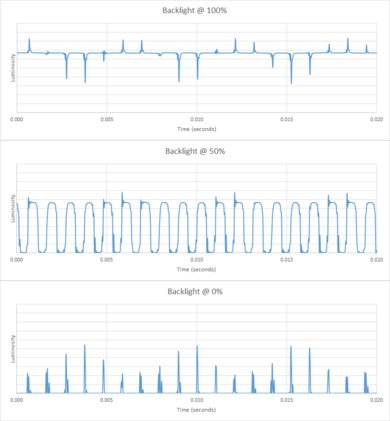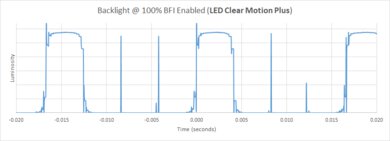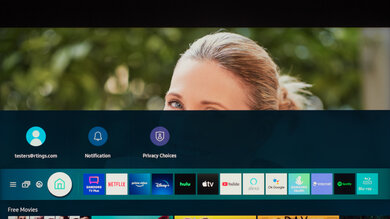The Samsung QN90A QLED is a flagship 4k LED TV. It's part of Samsung's 2021 Neo QLED lineup, which combines Mini LED backlighting with a quantum dot layer to display a wide range of colors at various luminance levels. The Mini LED backlighting helps the TV display deeper blacks as it has greater control over its local dimming feature, and it also gets very bright, enough to combat glare or bring out highlights. It comes with the Tizen smart platform, which is easy-to-use and has a ton of apps available to download, and the new remote has a solar panel in the back, so it uses sunlight to charge. It comes with a bunch of gaming features like variable refresh rate (VRR) support and HDMI 2.1 bandwidth, but only on one port, which is disappointing as you can't take full advantage of two next-gen gaming consoles at the same time.
Our Verdict
The Samsung QN90A is an excellent TV for any use. It's excellent for movies in dark rooms as its VA panel provides an excellent native contrast ratio and has a great local dimming to display deep blacks. It gets bright enough to combat glare and has fantastic reflection handling if you want to use it in a well-lit room while watching shows and sports. It also displays a wide range of colors for an excellent HDR experience. Also, it's amazing for gaming because it has variable refresh rate (VRR) support, low input lag, and quick response time for smooth motion handling.
- Excellent native contrast ratio.
- Great Mini LED full-array local dimming feature.
- Removes 24p judder from any content.
- Decent viewing angle.
- Incredible HDR peak brightness.
- A bit of blooming noticeable around bright objects.
The Samsung QN90A is excellent for watching TV shows in a bright room. It easily gets bright enough to combat glare in well-lit rooms and has fantastic reflection handling, meaning visibility won't be an issue. It has a wide viewing angle, so the image remains accurate when viewing from the side, which is great for watching shows with the entire family. Lastly, it upscales lower-resolution content like cable TV without any issues.
- Removes 24p judder from any content.
- Gets bright enough to combat glare.
- Fantastic reflection handling.
- Decent viewing angle.
- Some dirty screen effect visible in the center.
The Samsung QN90A is excellent for watching sports. Fast-moving content looks smooth thanks to its very quick response time, and it has a backlight strobing feature to help reduce motion blur. It's great for viewing in bright rooms thanks to its fantastic reflection handling and very high peak brightness. It has a decent viewing angle if you want to watch the big game with a few friends.
- Removes 24p judder from any content.
- Gets bright enough to combat glare.
- Decent viewing angle.
- Very quick response time results in smooth motion.
- Some dirty screen effect visible in the center.
The Samsung QN90A is amazing for gaming. It's packed with gaming features like HDMI 2.1 bandwidth and VRR support. Its 120Hz panel has a very quick response time, resulting in smooth motion, and the input lag is very low. It's great for dark room gaming thanks to its excellent native contrast ratio, but the local dimming feature performs worse in Game Mode than outside of it. Sadly, it only has one HDMI port that supports HDMI 2.1, so you can't take full advantage of both the PS5 and Xbox Series X if you connect them at the same time.
- Excellent native contrast ratio.
- Removes 24p judder from any content.
- Very quick response time results in smooth motion.
- FreeSync VRR support.
- Very low input lag.
- A bit of blooming noticeable around bright objects.
The Samsung QN90A is excellent for watching HDR movies. It displays a wide color gamut, and it supports HDR10+, but not Dolby Vision, so you can't take advantage of the Dolby Vision format in some streaming content. It gets bright enough to make highlights pop, has an excellent native contrast ratio, and its Mini LED local dimming feature helps it display deep blacks. It also has fantastic black uniformity, but there's still some blooming around bright objects.
- Excellent native contrast ratio.
- Great Mini LED full-array local dimming feature.
- Removes 24p judder from any content.
- Incredible HDR peak brightness.
- Displays wide color gamut.
- A bit of blooming noticeable around bright objects.
- No Dolby Vision support.
The Samsung QN90A is amazing for HDR gaming. It's excellent for gaming, thanks to its very quick response time and low input lag. It has native FreeSync support and G-SYNC compatibility to reduce screen tearing. In terms of HDR, it displays a wide color gamut and has incredible HDR brightness in Game Mode. It also has an excellent native contrast ratio to provide a great dark room gaming experience, but its local dimming feature isn't as good in Game Mode.
- Removes 24p judder from any content.
- Very quick response time results in smooth motion.
- FreeSync VRR support.
- Incredible HDR peak brightness.
- Displays wide color gamut.
- A bit of blooming noticeable around bright objects.
The Samsung QN90A is an excellent choice to use as a PC monitor. It has a very low input lag and quick response time to provide a responsive gaming experience. Thanks to its wide viewing angle, the image remains mostly accurate at the edges if you sit too close. You also won't have any issues in a well-lit room either, as it gets bright enough to combat glare and has fantastic reflection handling. Lastly, it displays proper chroma 4:4:4 with most signals, which helps it display clear text.
- Removes 24p judder from any content.
- Gets bright enough to combat glare.
- Decent viewing angle.
- Very quick response time results in smooth motion.
- Very low input lag.
- Some dirty screen effect visible in the center.
Changelog
- Updated Sep 26, 2025: We uploaded the latest brightness measurements and uniformity photos for the Accelerated Longevity Test.
- Updated Jul 08, 2025: We uploaded the latest brightness measurements and uniformity photos for the Accelerated Longevity Test.
- Updated Apr 17, 2025: We uploaded the latest brightness measurements and uniformity photos for the Accelerated Longevity Test.
- Updated Feb 11, 2025: We uploaded the latest brightness measurements and uniformity photos for the Accelerated Longevity Test.
Check Price
Differences Between Sizes And Variants
We tested the 55 inch Samsung QN90A, and for the most part, the review is valid for the 65 inch, 75 inch, 85 inch, and 98 inch variants available in North America. There's a 43 inch variant, but it has a lower refresh rate and doesn't support HDMI 2.1 bandwidth, so it performs differently than the other models. Also, the 50 inch model has the same features but doesn't use the 'Ultra Viewing Angle' technology.
You'll also see it as the Samsung QN9, QN9D, or QN9DA at warehouse retailers like Costco or Sam's Club. Samsung's lineup is different in Europe, so this review isn't valid for the European QN90A, as the European equivalent is the QN94A, while the QN95A in Europe is similar but uses the One Connect Box. Below you can see the full model codes of each model, but keep in mind that the last six letters vary between countries and even different retailers.
| Size | US Model | Short Model Code | Refresh Rate | Variable Refresh Rate | Ultra Viewing Angle |
|---|---|---|---|---|---|
| 43" | QN43QN90AAFXZA | QN43QN90A | 60Hz | No | No |
| 50" | QN50QN90AAFXZA | QN50QN90A | 120Hz | Yes | No |
| 55" | QN55QN90AAFXZA | QN55QN90A | 120Hz | Yes | Yes |
| 65" | QN65QN90AAFXZA | QN65QN90A | 120Hz | Yes | Yes |
| 75" | QN75QN90AAFXZA | QN75QN90A | 120Hz | Yes | Yes |
| 85" | QN85QN90AAFXZA | QN85QN90A | 120Hz | Yes | Yes |
| 98" | QN98QN90AAFXZA | QN98QN90A | 120Hz | Yes | Yes |
If someone comes across a different type of panel or if their Samsung QN90A doesn't correspond to the review, let us know and we'll update the review. Note that some tests, like gray uniformity, may vary between units.
Our unit of the QN90A was manufactured in February 2021; you can see the label here. You can also see a picture of our service menu here.
Popular TV Comparisons
The Samsung QN90A is an excellent all-around TV with exceptional picture quality. It's an improvement over its predecessor, the Samsung Q90/Q90T QLED, mainly because the Mini LED backlighting provides brighter highlights. It's one of the best TVs we tested in 2021, but keep in mind that it's on the costly side, so only get this if you want the best picture quality possible, regardless of the price.
Also see our recommendations for the best Samsung TVs, the best QLED TVs, and the best 4k TVs.
The Samsung QN90A is a bit better than the Hisense U8G. The Samsung has better viewing angles, making it a better choice for a wide seating arrangement, and the local dimming feature is more effective at reducing black levels, improving contrast. The Samsung is also significantly brighter, but since the Hisense is also very bright, the difference is only noticeable with some content.
The Samsung QN90A is better than the Sony X95J, but if you really care about an accurate movie experience, some people might prefer the Sony. The Samsung has much better black uniformity and better contrast, but the Sony has a better local dimming feature, despite the Mini LED backlight on the Samsung. On the other hand, some people might prefer the Sony for watching HDR movies, as it tracks the EOTF more accurately, and many people prefer the processing on Sony TVs.
Overall, the Samsung QN90A is better than the Sony X90J. The Samsung has a much wider color gamut, and it gets a lot brighter, more than enough to deliver a true cinematic HDR experience. It has better viewing angles because it has Samsung's 'Ultra Viewing Angle' layer, but this layer also causes a drop in the contrast ratio. That said, the Samsung's local dimming is significantly more effective at improving the black level. The Samsung has better response times, and unlike the Sony, its Black Frame Insertion feature can flicker at 60Hz in 60 fps content. It has FreeSync VRR support to reduce screen tearing when gaming, and it supports 1440p @ 120Hz on the Xbox Series X, while the Sony can't.
The Samsung QN90B is very similar to its predecessor, the Samsung QN90A. The QN90B has a wider viewing angle but worse black uniformity and more noticeable blooming in dark scenes. Small highlights in HDR content in dark scenes are significantly brighter on the QN90B, so they pop more.

We buy and test dozens of TVs yearly, taking an objective, data-driven approach to deliver results you can trust. Our testing process is complex, with hundreds of individual tests that take over a week to complete. Most of our tests are done with specially designed test patterns that mimic real content, but we also use the same sources you have at home to ensure our results match the real-world experience. We use two main tools for our testing: a Colorimetry Research CR-100 colorimeter and a CR-250 spectroradiometer.
Test Results

The Samsung QN90A has a premium design that looks very similar to the Samsung Q90/Q90T QLED, except it's much thinner. It has a clean look with thin bezels that look good in any setup, and it's what you expect from a premium TV.
The back is made of an etched plastic panel and there are tracks for cable management. The inputs are side-facing, but because they're set into the TV with a wall around them, they're hard to reach if you wall-mount the TV.
The Samsung QN90A's build quality is fantastic. Although the entire TV, except for the stand, is made of plastic, it feels very solid and well-put-together. The textured plastic feels premium. There aren't any obvious issues or loose parts, which is what you'd expect from a high-end model. It's a bit wobbly on the stand, but that's because the panel is so thin and easy to move, and it won't be an issue unless you regularly move your TV around.
The Samsung 55QN90A has remarkable HDR brightness. Small highlights stand out the way they are expected to, but in SDR, large areas are less bright due to the aggressive ABL. Surprisingly, real content gets even brighter than the test slides, so this TV delivers an impactful HDR experience. Real scenes are brighter than the Samsung QN90B QLED, but small highlights in dark scenes aren't as bright.
The EOTF follows the target PQ curve fairly well, but the overall image looks brighter than intended. It has a slow roll-off at its peak brightness, meaning you won't lose details in bright objects. If you still find the image too dim, then set Contrast Enhancer to 'High' and ST.2084 to its max. This results in a noticeably brighter image, as you can see in this EOTF, but it doesn't change the peak luminosity.
These results are from the 'Movie HDR' Picture Mode with Local Dimming on 'High', and Brightness and Contrast at their max, with all other image processing disabled.
The HDR brightness in Game Mode is incredible. It's only slightly more dim than outside of Game Mode, and it's still bright enough to make highlights stand out in HDR games. There's no frame dimming with small highlights either, but you have to update the TV to its latest firmware to be like that.
The EOTF follows the target better than outside of Game Mode, but some bright scenes are still over-brightened. You can make it brighter by using the same settings as outside of Game Mode.
These results are with Game Mode enabled, Local Dimming on 'High', Brightness and Contrast at their max, Color Tone set to 'Warm2', Sharpness at '0', and Color Gamut on 'Auto'. There's a new Game HDR setting, and it's meant to optimize the brightness according to the content. It resulted in a less bright image than originally tested, but feel free to enable it if you find it looks better with your game.
The Samsung QN90A has outstanding SDR brightness, and it gets much brighter than the Sony X95J. It easily gets bright enough to combat glare in well-lit rooms. However, the Automatic Brightness Limiter (ABL) causes large areas of bright colors, like in a hockey or basketball broadcast, to be more dim.
These results are from after calibration in the 'Movie' Picture Mode with Color Tone set to 'Warm2', Brightness to its max, and Local Dimming on 'High'.
If you want the brightest image possible and don't mind losing some image accuracy, set the Picture Mode to 'Dynamic' with Color Tone on 'Standard'. It reaches 1,511 cd/m² in the 10% window using these settings.
The Samsung QN90A displays an excellent wide color gamut for HDR content. It has exceptional coverage of the DCI-P3 color space used in most HDR content. It even has decent coverage of the Rec. 2020 color space, which is important because more content will start to come out with this color space.
The Samsung QN90A has a great color volume. It displays bright and dark colors well, thanks to its high peak brightness and contrast ratio, meaning colors look vivid and highlights pop.
The Samsung QN90A has exceptional out-of-the-box accuracy, so you won't need to calibrate it for the best accuracy possible. Any white balance and color inaccuracies can't be spotted by the human eye, and the color temperature is close to the 6500K target. Gamma follows the target curve well overall, but dark scenes are too dark, and bright scenes are over-brightened, but neither are too noticeable.
The accuracy post-calibration is remarkable. Gamma now follows the target curve a lot better and the color temperature is even closer to the target.
You can see the recommended settings here.
This TV has decent gray uniformity. The edges of the screen are slightly darker than the rest of the screen, and there's dirty screen effect in the center, which gets distracting during sports. Luckily, uniformity is much improved in near-dark scenes.
The Samsung QN90A has a decent viewing angle thanks to Samsung's 'Ultra Viewing Angle' technology. The image remains accurate when viewing from the side, but you'll see that the screen looks darker at really wide angles. Still, it's a good choice if you want to watch shows or sports with a few people around.
The Samsung QN90A has fantastic reflection handling. It handles external light sources well, but light scatters across the screen, creating a rainbow-like effect. It can be distracting during dim or dark scenes, as even indirect and dim light sources can cause this rainbow-like effect. However, it gets bright enough to fight glare with bright scenes, meaning they won't be as much of an issue.
The Samsung QN90A uses a BGR sub-pixel layout, which negatively impacts how it displays text when using the TV as a PC monitor. You can read more about that here. The pixels look a bit blurry due to the 'Ultra Viewing Angle' layer.
The Samsung QN90A has an excellent response time. For the most part, motion looks smooth, and there's minimal blur. However, there's some overshoot in the darker transitions, which leads to inverse ghosting, as seen with the trailing letter R, but it's not distracting.
The Samsung QN90A uses pulse width modulation (PWM) to dim its backlight. It flickers at such a high frequency that you won't notice it. However, the flicker frequency drops to 120Hz in the 'Dynamic', 'Natural', 'Standard', and 'Filmmaker' Picture Modes, or if you enable the Game Mode or Picture Clarity settings, but it flickers again at 960Hz with VRR enabled. This low flicker frequency can cause headaches if you're sensitive to flicker, and it also causes image duplications with 60Hz content.
The Samsung QN90A has a backlight strobing feature, commonly known as black frame insertion, to reduce persistence blur. You can make it flicker at either 60Hz or 120Hz, and it helps reduce persistence blur, but it also introduces some image duplication. You can see that there's a duplicate R trailing the RTINGS logo. Note that the BFI scoring is based on whether it can flicker at 60Hz and 120Hz and not the actual performance.
The Samsung QN90A has a motion interpolation feature. It can interpolate 30 fps and 60 fps content up to 120 fps, known as the 'Soap Opera Effect'. It works properly in slow scenes, but many small artifacts appear when there are fast-moving objects on the screen. It can get distracting during busy scenes.
Due to the fast response time, lower-frame-rate content appears to stutter as each frame is held on longer. If it bothers you, try enabling the motion interpolation feature.
The Samsung QN90A automatically removes judder from all sources, and there aren't any settings you need to enable. It helps with the appearance of motion in movies, as each frame displays for a consistent amount of time.
The Samsung QN90A supports FreeSync VRR natively to reduce screen tearing. It works without any issues at its full refresh rate range. Although G-SYNC didn't work at launch, G-SYNC compatibility works, despite not being certified by NVIDIA, as long as you're on firmware version 1066 or higher.
The Samsung QN90A has incredibly low input lag in Game Mode. You can enable the motion interpolation feature in Game Mode, and although it increases the input lag, it's still low enough if you don't play competitive reaction-based games. Sadly, we couldn't properly measure the VRR input lag because it was giving us inconsistent readings. We experienced this with other TVs, and it's unclear whether it's an issue with the testing or the TV.
The Samsung QN90A supports all common resolutions up to 4k @ 120Hz. It also displays proper chroma 4:4:4 at every supported resolution, except for 1440p @ 120Hz, which helps it display clear text when you're using it as a PC monitor. Unlike other TVs like the Sony X90J and the Hisense U8G, this one doesn't have any issues displaying 4k @ 120Hz content properly. Samsung uses a different chipset than other brands, meaning you won't experience the same resolution halving issues.
Unlike Samsung's 2020 models, the Samsung QN90A doesn't have any issues displaying content from either the PS5 or the Xbox Series with 4k games up to 120 fps. It also has an Auto Low Latency Mode that switches the TV into Game Mode when launching a game from a compatible device.
Additionally, there's a new feature that you can access on Samsung TVs in 2021. If you hold the Play/Pause button on the remote, it brings up the 'Game Bar' page, showing you whether VRR is working and other useful gaming info. You can see what it looks like here.
Some owners have reported an issue with colors washing out in certain picture modes, like in Game Mode. We tried to reproduce the issue on our unit, but it's nowhere near as bad as other owners have reported. If you experience the same thing, let us know.
HDMI 4 is the only input that supports HDMI 2.1 bandwidth. It's disappointing if you need to connect more than one HDMI 2.1 device, like if you have both a PS5 and Xbox Series X, so you can't take full advantage of them. You can connect an HDMI 2.1 receiver if that's the case, but you can't use the Xbox's VRR support. On the Samsung QN95A model in Europe, which comes with the One Connect box, there are four HDMI 2.1 inputs.
Both of the USB inputs are USB 2.0. It's also advertised to support ATSC 3.0, allowing you to receive over-the-air 4k channels in supported regions.
The Samsung QN90A supports passthrough for Dolby audio formats, including Dolby Atmos via TrueHD through eARC. However, it doesn't support any DTS passthrough, which is disappointing as many Blu-rays use this format.
The Samsung QN90A has an okay frequency response. It has a very well-balanced sound profile and gets loud enough for most environments, but it doesn't produce much bass.
The distortion performance is good. There isn't too much audible distortion even when playing at its max volume, but there's more distortion in the treble range when playing content at its max volume.
Samsung released a redesigned remote for the QLED TVs in 2021, with a similar design to 2020's Samsung The Terrace. It still has the same quick-access buttons as the previous model but with brushed plastic at the bottom. The remote doesn't use disposable batteries anymore, and there's a solar panel on the back so you can charge it that way or with a USB-C cable. The voice control with Samsung's Bixby does most common demands, like opening apps, changing inputs, and changing settings, but it can't search for specific content in apps.























































